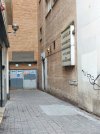Always been fascinated by this thoroughfare....especially the Pubs and Hotels......and also the Aquarium highlighted in mikejee's map from way back....so here's some more pics to add to the collection, and I love Joe Mckenna's take on it's history, and notably again...for it's role in the history of Birmingham's Theatres! And I include two old maps showing the hostelries quite nicely....
He wrote thus: Two doors further on, though several centuries earlier, was the Reindeer, at what was to become 41 High Street. A mid to late seventeenth-century inn, its licensee in 1663 was John Moorland. In 1691 it became a coaching inn. There is an advertisement to this effect in the
London Gazette for 7-11 May: There is a stage-coach goes from the Rain-Deer Inn, in Birmingham, every Monday Morning, 6 o'clock, going through Warwick and Banbury, and comes to the Bell Inn, in West-Smithfield, every Wednesday, and so returns every Thursday, to the Rain-Deer Inn, in Birmingham, every Saturday at 18s. each Passenger. Performed by Nich. Rothwell, of Warwick.
Two years later, in 1693, the building was refaced in brick by builder Richard Pinley. In the early eighteenth century the house was renamed the Castle Inn. Dr Samuel Johnson stayed here in the autumn of 1734. In the stable belonging to the inn was held the first theatrical performance in the town under a permanent cover, before a dedicated theatre was erected in Moor Street. Wiki states: A building "something like a stable" in Castle Yard between High Street and Moor Street was used for dramatic performances from 1730. The standard of production in this new venue was reflected in the remarks of
William Hutton, writing later in the century: "here the comedian strutted in painted rags, ornamented with tinsel. The audience raised a noisy laugh, half real and half forced, at three-pence a head”. Not all of the performances of this era were of such low quality, however: later playbills suggest that
George Hallam had visited Birmingham with a company of actors from London, and that a repertoire of good quality was being presented in the town, by 1730 at the latest.
John Camden was landlord here between 1767 and 1770. On 22 May 1769 the first meeting of the Commissioners of the Birmingham Lamp Act took place at the Castle Inn, where apparently they continued to meet for some time thereafter.
Samuel Lloyd succeeded Camden. A Mr Piper ran this coaching inn after Lloyd. His widow continued until her retirement in 1785. John Ibberson, whose father ran the George & Blue Boar in Holborn, London, bought the house. During his time the Castle acted as the meeting place of the magistrates during the Scarcity Riots of 1800.
Ibberson was succeeded by another Londoner, William Waddell, who later took over the rival coaching inn, the Hen & Chickens in New Street. When put up for sale in 1812, an advertisement in the
Birmingham Gazette (12 October) revealed that the Castle had four dining rooms and twenty-three bedrooms.
William Chapman took over the license, he was followed by John and Thomas Law, and finally, William Felton. The Castle was closed in 1854. Edward Gem, an export merchant, purchased one part, Joseph Barrow the other. Barrow took over the Castle's license, put in new windows, and opened a wine and spirits merchants called the Castle Vaults. This closed down in May 1922.

















